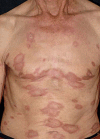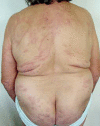Leprosy: review of the epidemiological, clinical, and etiopathogenic aspects - part 1
- PMID: 24770495
- PMCID: PMC4008049
- DOI: 10.1590/abd1806-4841.20142450
Leprosy: review of the epidemiological, clinical, and etiopathogenic aspects - part 1
Abstract
Leprosy is caused by Mycobacterium leprae and has been known since biblical times. It is still endemic in many regions of the world and a public health problem in Brazil. The prevalence rate in 2011 reached 1.54 cases per 10,000 inhabitants in Brazil. The mechanism of transmission of leprosy consists of prolonged close contact between susceptible and genetically predisposed individuals and untreated multibacillary patients. Transmission occurs through inhalation of bacilli present in upper airway secretion. The nasal mucosa is the main entry or exit route of M. leprae. The deeper understanding of the structural and biological characteristics of M. leprae, the sequencing of its genome, along with the advances in understanding the mechanisms of host immune response against the bacilli, dependent on genetic susceptibility, have contributed to the understanding of the pathogenesis, variations in the clinical characteristics, and progression of the disease. This article aims to update dermatologist on epidemiological, clinical, and etiopathogenic leprosy aspects.
Conflict of interest statement
Conflict of Interest: None.
Figures










References
-
- Eidt LM. Breve história da hanseníase: sua expansão do mundo para as Américas, o Brasil e o Rio Grande do Sul e sua trajetória na saúde pública brasileira. Saúde Soc. 2004;13:76–88.
-
- Cavaliere IAL, Costa SG. Isolamento social, sociabilidades e redes sociais de cuidados. Physis. 2011;21:491–516.
-
- Cunha VS. solated 'like us' or isolated 'among us'?: the controversy within the National Academy of Medicine over compulsory isolation of leprosy sufferers. Hist Cienc Saude Manguinhos. 2010;17:939–954. - PubMed
-
- Opromolla PA, Martelli ACC. Terminology related to Hansen's disease. An Bras Dermatol. 2005;80:293–294.
-
- Global leprosy situation, 2012. Wkly Epidemiol Rec. 2012;87:317–328. - PubMed
Publication types
MeSH terms
LinkOut - more resources
Full Text Sources
Other Literature Sources
Medical
